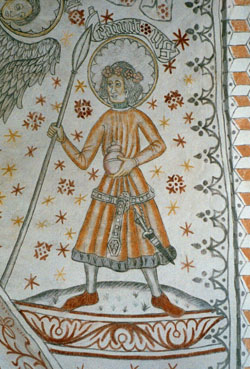
Feastday: January 7
Patron: of Zealand, Denmark
Birth: 1096
Death: 1131
St. Canute Lavard, not to be confused with Canute IV of Denmark, was a Danish prince born on March 12, 1096, as the only legitimate son of King Eric I of Denmark. Growing up, Canute was in close contact with the noble family of Hvide.
In 1115, at 19-years-old, St. Canute Lavard was placed in charge of the Duchy of Schleswig by his uncle, King Niels of Denmark. During the next 15 years, Canute successfully established peace in the border area. He spent years of his life defending his area against Viking raids and supporting the missionary work of St. Vicelin. He did so well, he was given the title Duke of Holstein and became a land holder of the Holy Roman Empire.
St. Canute Lavard was the first member of the Danish royal family to be attracted by knightly ideals and medieval German habits. Canute went on to change his title to Duke of Schleswig.
Though his appearance made him very popular and listed as a possible successor of his uncle, Canute had several great enemies among other Danish princes and wealthy persons. They questioned his loyalty to the country and feared his bond with Emperor Lothair II, whom Canute tried to evangelize.
Caunute's uncle, Niels, and cousin, Magnus the Strong, were alarmed by Canute's recognition as King of the Western Wends by the emperor. This fear led Magnus and Canute's other cousin, Henry Skadelaar, to murder Canute on January 7, 1131, as he was trapped in the Haraldsted Forest near Ringsted in Zealand.
St. Canute Lavard's initial resting place was in the Ringsted Abbey, one of the earliest Benedictine houses in Denmark, but in 1157, his remains were transferred to St. Bendt's Church, a new chapel in Ringsted. His death provoked a civil war that lasted until 1157, and ended with the triumph of Canute's own son, Valdemar I.
Canute was canonized by Pope Alexander III in 1169, at the request of King Valdemar. He is often depicted as a knight with a wreath, lance and ciborium. St. Canute Lavard is the patron saint of Zealand and Denmark, and his feast day is celebrated on January 7.
Not to be confused with Canute IV of Denmark.Canute Lavard (Danish: Knud Lavard) (March 12, 1096 – 7 January 1131) was a Danish prince. Later he was the first Duke of Schleswig and the first border prince who was both a Danish and a German vassal, a position leading towards the historical double position of Southern Jutland. He was killed by his cousin Magnus (later King Magnus I of Sweden; ca. 1106–1134), who saw him as a rival to the Danish throne. Canute Lavard was canonized in 1170.
He was an ancestor of the Valdemarian kings (Valdemarerne) and of their subsequent royal line. Canute Lavard was the father of King Valdemar I of Denmark (Valdemar den Store) and grandfather of King Valdemar II of Denmark (Valdemar Sejr).
Biography
Canute was the only legitimate son of King Eric I of Denmark (died 1103) and Boedil Thurgotsdatter, but as a minor he was bypassed in the election of 1104. He grew up in close contact with the noble family of Hvide, who were later on to be among his most eager supporters. In 1115, his uncle, King Niels of Denmark, placed him in charge of the Duchy of Schleswig (jarl af Sønderjylland) in order to put an end to the attacks of the Slavic Obotrites. During the next fifteen years, he fulfilled his duty of establishing peace in the border area so well that he was titled Duke of Holstein (Hertug af Holsten) and became a vassal of the Holy Roman Empire.
He seems to have been the first member of the Danish royal family who was attracted by the knightly ideals and habits of medieval Germany, indicated by his changing his title to Duke of Schleswig (Hertug af Slesvig). His appearance made him a popular man and a possible successor of his uncle, but he also acquired mighty enemies among the Danish princes and magnates, who apparently questioned his loyalty and feared his bond with Emperor Lothair III, who had recognized him as sovereign over the western Wends.
Both Niels and his son, Magnus the Strong, seem to have been alarmed by Canute's recognition by the emperor. On 7 January 1131, Canute was trapped in the Haraldsted Forest (Haraldsted Skov) near Ringsted in Zealand and murdered by Magnus. Ringsted Abbey, one of the earliest Benedictine houses in Denmark, became the initial resting place of Canute Lavard. In 1157, Canute Lavard's remains were moved into a new chapel at St. Bendt's Church in Ringsted. A chapel (Knut Lavards Kapel) was erected at the site of his death during medieval times but disappeared after the Reformation. The ruins were rediscovered in 1883. In 1902 a memorial in the form of a 4-metre crucifix was erected near the site of the death of Canute Lavard.
After the death of Canute Lavard, the Obotrite lands were partitioned between Pribislav and Niklot (1090–1160), both chiefs of the Obotrites. Some sources consider the death of Canute to be a murder committed by Magnus; some attribute it to Niels himself. The death provoked a civil war that intermittently lasted until 1157, ending only with the triumph of Canute's posthumous son Valdemar I. The fate of Canute and his son's victory formed the background for his canonisation in 1170, which was requested by King Valdemar. His feast day (Knutsdagen) is celebrated on the day of his death, January 7.
Issue
Canute Lavard was married to Ingeborg of Kiev, daughter of Mstislav I of Kiev and Christina Ingesdotter of Sweden. They had four children:
- Margaret, married Stig Hvitaledr
- Christina (b. 1118), married (1133) Magnus IV of Norway
- Catherine, married Prislav, son of Niklot, prince of Obotrites
- Valdemar I of Denmark (born 1131)





